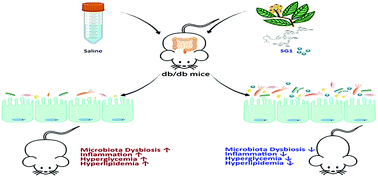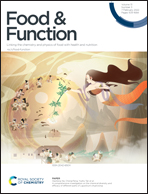Sesquiterpene glycoside isolated from loquat leaf targets gut microbiota to prevent type 2 diabetes mellitus in db/db mice
Abstract
According to ancient records, loquat leaf has been used as both a food and medicine in China for thousands of years. Sesquiterpene glycosides from loquat leaf have achieved remarkable effects on hyperglycemia. However, their specific activities and underlying mechanisms on type 2 diabetes mellitus (T2DM) are not fully understood. In the present study, we found that SG1, a unique sesquiterpene glycoside isolated from loquat leaf, had the capability to prevent insulin resistance and inflammation. In db/db mice, SG1 administration (25 and 50 mg kg−1 day−1) inhibited hyperglycemia and the release of inflammatory cytokines. To further explore the possible role of gut microbiota in SG1 for treating T2DM, we applied 16S rRNA pyrosequencing based on the V3–V4 region to analyze the fecal samples of different groups. Alpha diversity analysis showed that SG1 administration could obviously increase diversity and richness in db/db mice. At the phylum level, due to SG1 treatment, the relative abundance of Firmicutes and Actinobacteria was lowered while that of Bacteroidetes was raised. Additionally, 7 key genera in the db/db mice with SG1 supplementation were enriched: Lactobacillus, Lachnospiraceae_NK4A136_group, and Ruminococcus, Bacteroides, Prevotellaceae_UCG-001, Alistipes, and Roseburia. These findings proved that SG1 could prevent T2DM by relieving insulin resistance and inflammation and by remodeling the gut microbiota in db/db mice.



 Please wait while we load your content...
Please wait while we load your content...